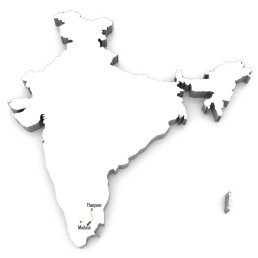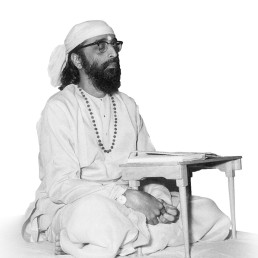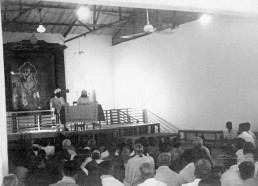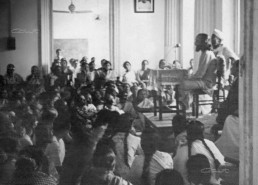
Jnana Yajna 21

Year & Dates:
August 05, 1956 to September 05, 1956

Yajna Topic:
Bhagavad Gita- Chapters 12 & 13

Place:
Madurai, India.
Madurai Railway station was a hub of great excitement on the morning of August 5, 1956, as four thousand devotees waited eagerly for the train arriving from Thanjavur. Seeing Pujya Gurudev Swami Chinmayananda emerge from the compartment was a moment of sheer joy. The temple elephant, ornate and majestic, garlanded him with a joyous trumpeting. Resonant Naada-svara music and percussion accompaniments set the tone for an auspicious beginning.
As thousands chanted the Mahamantra, Pujya Gurudev walked regally behind a decorated car that carried the sacred Ganga Kalashas that would later purify the Yajna audience.
The Field of Love Supreme
The royal welcome indicated how much the Madurai audience was elated about the 31-day Gita Jnana Yajna on chapters 12 and 13. “This is my place, the land of Shiva!” Pujya Gurudev remarked with great love for the legendary Meenakshi-Sundareshwara temple in Madurai. The place was apt for Pujya Gurudev to bring out the profound yoga of devotion in Gita chapter 12. As He explained the attributes of a true devotee, the audience could visualize how a limited ego dissolves in complete identification with the Supreme. In His words, the audience heard the echoes of Saiva Siddhanta, the bhakti-focused literature composed by Tamil saints. He then skillfully spotlighted the essence of Chapter 13 – the way to first distinguish the Kshetra, the inert field of matter and instruments of knowledge, from the enlivening spark of life, the Kshetrajna or Knower. Pujya Gurudev stole the hearts of the large audience in Madurai, personifying an environment of Knowledge sweetened with supreme Love.
In Admiration
The lasting impression of how Pujya Gurudev conducted himself during the talks made an indelible mark on Shri P Chandrasekhar. He wrote: “The punctuality of the Master definitely teaches one that, in religious life, one should be punctual and methodical. The Adhyaksha is so neat and attractive that it removes any misconception that Masters can be shabby and that it has religious sanction. There is military discipline in the Yajna Shala and no interference with it is tolerated.”
Photo Gallery

“Think,” Says Pujya Gurudev
The Path of Devotion is not a mere sentimental explosion or an excessive emotional display. It is not mere frivolous hysteria. It should be a steady inward blossoming of the human personality through discard of all our limitations and acquisition of new vitality during the inspired moments of deep contemplation.
From Bhagavad Gita- Chapters 12 & 13 Book
No wave is all the ocean; all the waves put together are not also the entire ocean. We cannot say the ocean is attached to the waves since the ocean is the very nature of the waves; and though detached, all waves are always supported by none other than the ocean itself. Cotton is in all cloth; cloth is not in cotton. And yet, it is the cotton in the cloth that supports the cloth. Similarly, the world of plurality is not the Consciousness. Yet the Consciousness supports it. Between the ghost and the post, no attachment is ever possible, and yet the post alone is the support of the ghost – as the waking mind alone can support the dreams.
From Bhagavad Gita- Chapters 12 & 13 Book
What is True Devotion?



